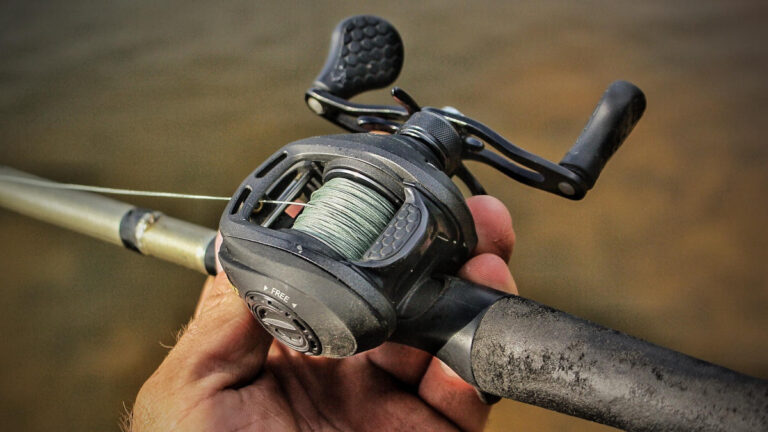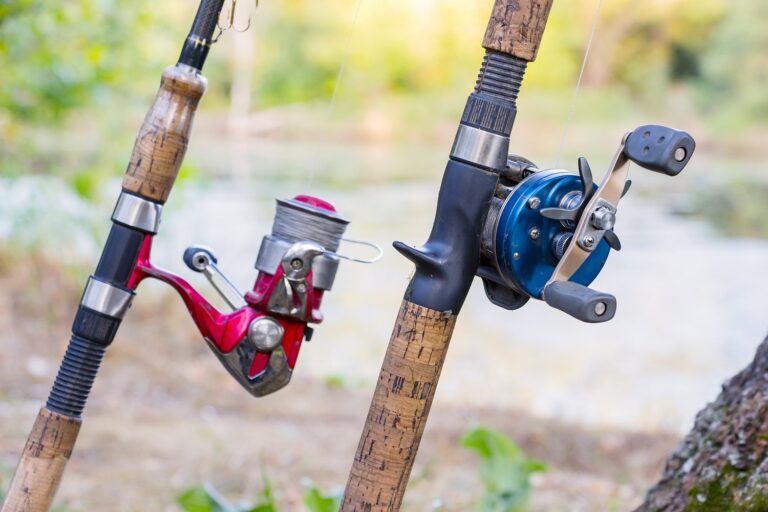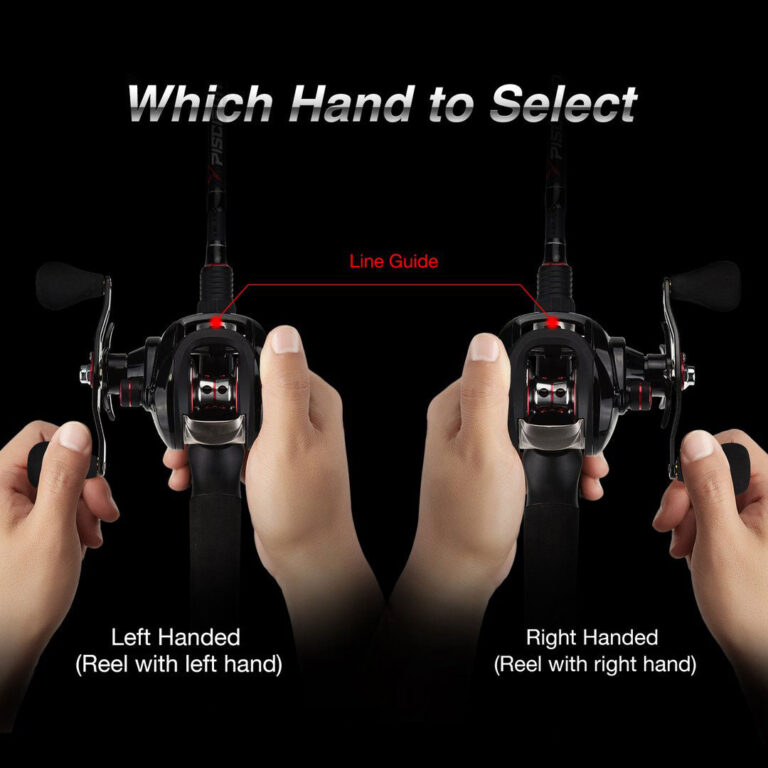To cast a baitcasting reel, hold the rod at a 45-degree angle, press the spool release button, and release the line with a quick flick of the wrist. This technique allows the bait to be accurately thrown into the desired location.
Fishing enthusiasts often rely on baitcasting reels to make precise and powerful casts. These reels provide greater control and accuracy compared to other types of fishing reels. However, mastering the technique of casting a baitcasting reel can seem daunting for beginners.
In this guide, we will break down the process into simple steps to help you cast your baitcasting reel like a pro. By following these instructions, you’ll be able to efficiently and effectively cast your fishing line, ensuring that your bait reaches the desired location with accuracy. So, let’s dive in and learn how to cast a baitcasting reel like a seasoned angler.

Credit: www.zawraqmarinetech.com
Understanding The Basics Of Baitcasting Reels
Baitcasting reels are a popular choice among anglers, offering a combination of power and precision that allows for accurate casting and excellent control over the line. However, using a baitcasting reel can be a bit tricky for beginners. In this section, we will delve into the key aspects of baitcasting reels, including what they are, their components, and the advantages and disadvantages of using them.
So, let’s dive in!
What Is A Baitcasting Reel?
A baitcasting reel is a type of fishing reel that is designed for advanced anglers. Unlike spinning reels, which have a fixed spool, baitcasting reels feature a revolving spool that sits on top of the rod. This design allows for a higher level of control and precision during casting, making them suitable for various fishing techniques such as lure fishing, trolling, and heavy-duty applications.
Components Of A Baitcasting Reel
Baitcasting reels consist of several essential components that work together to provide a smooth and efficient fishing experience. Here are the key components you should know about:
- Spool: The spool is where the fishing line is stored. It rotates as you cast or retrieve the line. It is essential to choose a reel with a spool capacity suitable for your fishing needs.
- Brake system: Baitcasting reels come with different braking systems such as centrifugal and magnetic brakes. These systems help control the rotation of the spool during casting, preventing backlash and ensuring a smooth release of the line.
- Handle: The handle allows you to reel in the line. Look for a reel with a comfortable and ergonomic handle design.
- Drag system: The drag system controls the amount of resistance applied to the line when a fish pulls on it. A good drag system ensures smooth and secure control over the line.
Advantages And Disadvantages Of Using A Baitcasting Reel
Using a baitcasting reel has its pros and cons. Here are the advantages and disadvantages you should take into consideration:
Advantages:
- Greater casting distance and accuracy: Baitcasting reels excel in long-distance casting and precise lure placement, making them ideal for targeting specific areas.
- Power and control: Baitcasting reels offer a higher gear ratio and stronger drag system, allowing you to tackle larger fish with ease.
- Versatility: Baitcasting reels can handle a wide range of fishing techniques, from finesse fishing to heavy-duty applications.
Disadvantages:
- Steeper learning curve: Baitcasting reels require practice and technique to finesse. Beginners may experience backlash or tangles until they get the hang of it.
- Less forgiving with line twists: Improper spool control can lead to line twists and tangles, requiring more maintenance compared to spinning reels.
Understanding the basics of baitcasting reels is crucial for any angler looking to improve their fishing skills. While they may not be the easiest reels to master, the benefits they offer make them a worthy investment. So, if you’re up for the challenge, give baitcasting reels a try and unlock your potential on the water!
Mastering The Technique Of Baitcasting Reel Casting
Casting a baitcasting reel may seem intimidating at first, but with practice and the right technique, it can become second nature. Whether you’re a beginner or an experienced angler looking to improve your casting skills, this section will guide you through the process step by step.
Let’s dive in and discover how to master the technique of baitcasting reel casting.
Choosing The Right Baitcasting Reel For Your Needs
- Consider the gear ratio: Higher gear ratios offer faster retrieval speeds, while lower gear ratios provide more power for reeling in larger fish.
- Check the line capacity: Ensure that the reel can hold enough line for your preferred fishing style and target species.
- Look for a quality braking system: Baitcasting reels often come with either magnetic or centrifugal braking systems to control the rotation of the spool.
- Consider the reel’s weight and comfort: A lightweight reel that feels comfortable in your hand will allow for extended periods of fishing without fatigue.
Setting Up Your Baitcasting Reel For Optimal Performance
- Spool your line correctly: Start by passing the line through the rod’s guides and tie it to the spool with an appropriate knot.
- Adjust the tension knob: Begin with a loose tension setting and gradually tighten it until the lure falls without resistance but doesn’t overrun.
- Fine-tune the braking system: Adjust the magnetic or centrifugal brakes to prevent backlash while casting, finding the right balance between control and distance.
Adjusting The Braking System To Prevent Backlash
- Magnetic braking system: Increase the magnetic setting to reduce the chance of backlash when casting into the wind or with lighter lures.
- Centrifugal braking system: Engage more brake weights for increased control when casting heavier lures or in situations that require more accuracy.
Gripping The Baitcasting Reel Handle Correctly
- Choose a comfortable grip: Experiment with different grip styles and find one that feels secure and allows for easy access to the casting controls.
- Use your dominant hand: For right-handed anglers, hold the rod with your left hand and cradle the reel with your right hand. The opposite applies to left-handed anglers.
Understanding The Casting Motion And Position
- Position your thumb correctly: Rest your thumb lightly on the spool to provide control during the casting process and prevent backlash.
- Hold the rod at the 10 to 11 o’clock position: Ensure that the rod is tilted slightly upward to maximize casting distance and accuracy.
Properly Releasing The Line During The Cast
- Apply pressure with your thumb: As you bring the rod forward during the cast, use your thumb to apply gentle pressure against the spool to control the line’s release.
- Release the line at the right moment: Coordinate the release with the forward motion of the rod to achieve optimal distance and accuracy.
Controlling The Speed And Distance Of Your Cast
- Master the timing and acceleration: Practice a smooth and controlled motion, gradually increasing the rod speed throughout the cast to generate more distance.
- Adjust the casting angle: Experiment with different casting angles to find the optimal trajectory and distance for your specific fishing scenario.
Avoiding Common Mistakes And Troubleshooting
- Start with lighter lures: Using heavier lures requires more precise timing and control, so beginners should begin practicing with lighter lures.
- Slow down your casting motion: Many backlash issues arise from overly aggressive or fast casting motions, so focus on a smooth and controlled motion.
- Practice, practice, practice: Casting a baitcasting reel requires time and patience to master, so don’t get discouraged and keep refining your technique.
With these tips and techniques in mind, you’ll be well on your way to becoming a proficient baitcasting reel caster. Remember, practice makes perfect, so head out to the water, hone your skills, and enjoy the thrill of successful casts and memorable fishing experiences!
Tips And Tricks For Advanced Baitcasting Reel Casting
Baitcasting reels are a popular choice among anglers who want to take their fishing experience to the next level. These advanced reels offer increased control, precision, and accuracy when casting. However, mastering the art of baitcasting reel casting requires practice, technique, and a few tips and tricks.
In this section, we will explore some valuable insights to help you fine-tune your casting skills with a baitcasting reel.
Fine-Tuning Your Casting Technique For Accuracy And Precision
- Master the thumb control: Proper thumb control is crucial for accurate and precise casting. Practice feathering the spool with your thumb to avoid backlash and achieve a smooth release.
- Adjust the brakes and spool tension: Tailor the braking system and spool tension to the weight of your lure and the conditions you’re fishing in. Experiment with different settings to find the ideal balance between distance and control.
- Utilize the rod’s power: Engage the power of the rod during the casting motion to generate distance and accuracy. Use a smooth, fluid motion, accelerating the rod on the forward cast and stopping abruptly at the end to transfer energy efficiently.
- Practice with different casting techniques: Try different casting techniques, such as flipping, pitching, and roll casting, to expand your repertoire and adapt to various fishing situations.
- Focus on your grip: Ensure a firm grip on the rod handle but avoid excessive tension in your hand. A relaxed grip allows for better wrist movement and finesse during the cast.
Casting Into The Wind Or In Different Weather Conditions
- Adjust your technique for wind resistance: In windy conditions, adjust your casting technique to minimize the wind’s effect on your line. Aim lower and cast at a sharper angle against the wind to reduce drag.
- Use heavier bait or weights: When casting into the wind, opt for heavier bait or weights to help counteract the wind’s force and maintain control over your cast.
- Choose the right line: Select a stiffer or heavier line, like fluorocarbon, which is less affected by wind resistance and allows for better accuracy in challenging weather conditions.
Using Different Bait Types And Weights For Varying Casting Techniques
- Match the weight of the bait to your rod: Use lighter baits for finesse techniques and heavier baits for power casting. Matching the bait weight to your rod’s specifications ensures proper balance and casting efficiency.
- Adjust your technique for different bait types: Different bait types, such as jigs, crankbaits, and soft plastics, require varying casting techniques. Experiment with different retrieves and presentations to find the most effective method for each bait.
Casting From Different Positions, Such As Sitting Or Standing
- Master the seated cast: When seated, focus on maintaining a steady body position and utilizing your upper body rotation and arm motion to generate power and accuracy.
- Adopt a stable standing posture: Stand with your feet shoulder-width apart, slightly staggered, for better balance. Practice transferring power from your legs to your casting arm while maintaining a stable base.
Practicing And Improving Your Casting Skills Over Time
- Dedicate time for regular practice: Consistent practice is essential to improve your casting skills. Set aside dedicated practice sessions to perfect your technique and build muscle memory.
- Focus on accuracy before distance: Start by honing your accuracy before focusing on distance. Once you can consistently hit your targets, gradually work on increasing your casting distance.
- Film and analyze your casts: Record your casting sessions and analyze them later to identify areas for improvement. This visual feedback can offer valuable insights into your technique and help you make adjustments.
Seeking Advice From Experienced Anglers And Professionals
- Join fishing communities: Engage with fishing communities, both online and offline, to connect with experienced anglers. Seek advice, attend workshops or seminars, and learn from their valuable insights and experiences.
- Follow professional anglers: Stay updated with professional anglers through their social media channels and websites. They often share tips, techniques, and advice that can help you enhance your baitcasting reel casting skills.
Exploring Alternative Casting Techniques With Advanced Baitcasting Reels
- Backlash reduction techniques: Learn techniques like thumb pressure modulation, reel braking adjustments, and proper casting motion to minimize the risk of backlash.
- Skipping and flipping: Practice skipping your bait across the water’s surface or flipping it into tight cover. These techniques can be effective in catching fish in challenging or hard-to-reach areas.
By incorporating these tips and tricks into your baitcasting reel casting routine, you’ll enhance your accuracy, precision, and adaptability in various fishing situations. Remember, practice makes perfect, so keep honing your skills and seeking new challenges to become an expert baitcaster.
Happy fishing!
Conclusion
Mastering the technique of casting a baitcasting reel is crucial for any angler looking to improve their fishing skills. By following these steps and practicing regularly, you can become confident and efficient in casting your baitcasting reel. Keep in mind the importance of adjusting your drag, setting the brakes, and using your thumb to control the line.
The key is to start with lighter lures and gradually work your way up to heavier ones as you become more comfortable. Remember to practice in open spaces to avoid any annoying tangles or snags. With patience and persistence, you will soon enjoy the smooth and accurate casts that a baitcasting reel can offer.
So, grab your reel, hit the water, and put your newfound knowledge into action. Happy fishing!



